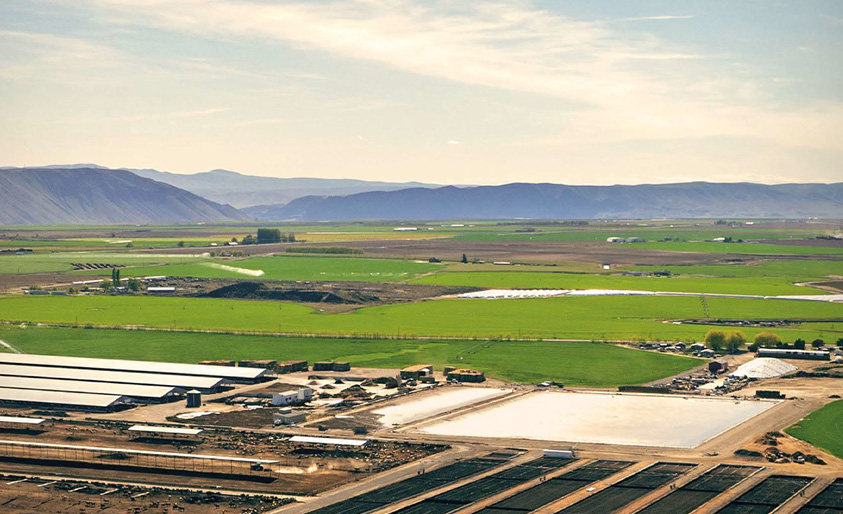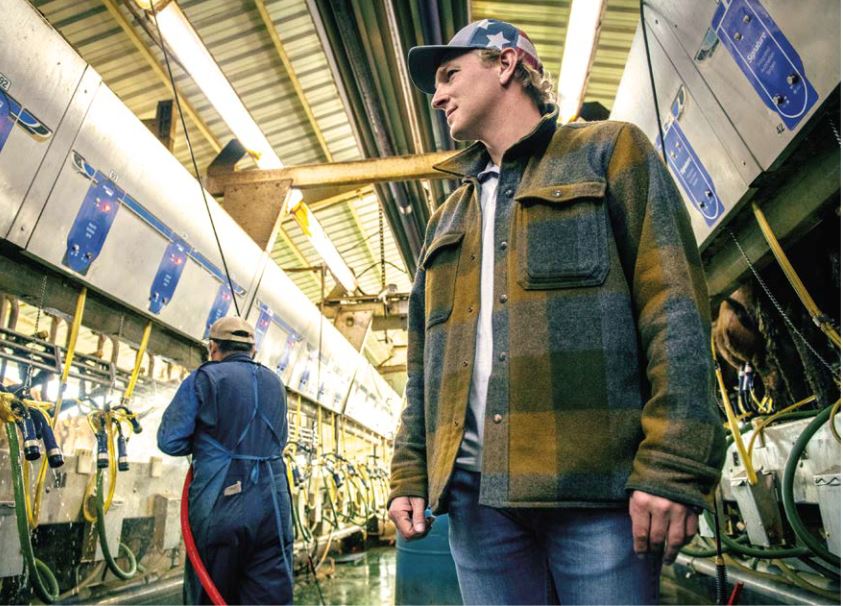Closing the loop through sustainable practices
In the heart of eastern Washington’s central desert, under the rain shadow of the Cascade Mountains, lies the Royal Slope growing region between Seattle and Spokane. Austin Allred’s family has been farming here since the early 1960s when the Columbia Basin Project turned thousands of sagebrush acres into farmable ground.
The Allreds have been building healthy, fertile soils in this area for three generations. It’s still the number one priority at Royal Family Farms, a diverse family business focused on innovation. Autonomously and together, Austin and his brothers, Derek and Tyson, grow potatoes, value-added cover crops and tree fruit, with Austin now managing dairy, beef cows and one of the world’s largest worm farms. Together they are pioneering regenerative farming practices at scale to reduce their reliance on inputs, build healthy soil, upcycle byproducts and reduce waste.
“We talk a lot about soil health, animal health and environmental health,” says Austin. “In nature, these symbiotic systems are all connected, and they build on each other. My dad, Jerry, is a longtime potato grower. For years we’ve used a system of rotating cover crops and no-till practices to build organic matter in the soil and sequester carbon. Then we’ve added cows in the farming ecosystem to upcycle the byproducts – potato culls and things humans can’t digest – to produce high-quality protein and nutrient-rich compost that goes back to our fields.”
When you work within nature’s systems there are bound to be unintended consequences. Austin says some will come in the form of benefits, and others will create new challenges to figure out. Dairy cows, for example, generate lots of solid waste that is ideal for making compost. But dealing with liquid waste is a completely different matter. This spurred the Allreds to build the first massive-scale worm farm to recycle liquid waste and generate clean irrigation water. Surprisingly, they also discovered a new fertilizer they say is perfect for growing plants.
Worm farm recycling
Imagine 8 acres of 5-foot-deep swimming pools. The bottom layer is rocks, about a foot deep. The next 4 feet are filled with woodchips and millions and millions of worms. Liquid waste from the dairy is applied to these pools through large sprinklers in the recycling process. Austin says this mild filtration system mirrors what happens naturally when water hits the earth. From there, worms digest the green water and through the process, remove any contaminants or heavy metals. Worms are also frisky little creatures. They mate interchangeably between males and females to “recreate” themselves over 200 times a year, adding another regenerative system to the farm.

“If a cow’s digestive system is the greatest creation to convert organic matter into protein and fertilizer, worms have to be a close second, ”says Austin. “Worm bodies naturally consume and process nutrients from green water and literally convert them into the perfect soil amendment. Worm poop castings are full of microbials, the good microorganisms we need for healthy soil. We’ve learned when you mix worm castings with compost or potting soil, you’re able to grow just about any plant you want.”
Working orchards into the system
On the Royal Slope, above the dairy and the Allreds’ 5,000-acre farm, they also grow a wide variety of apples and cherries. Tyson manages the orchards, and Derek runs a fruit-packing facility with strong ties to growers and processors in the area. Extended family members – uncles and cousins – also have farms and orchards on the slope. Fruit that doesn’t make the grade for consumer consumption is upcycled as feed for their cows and wood byproducts are recycled into chips for the worm farm, in partnership with CMI Orchards.
In the tree fruit industry, rapid changes in consumer preferences are creating challenges for growers. Some are being compelled to retire orchards with less popular varieties sooner and invest in costly infrastructure to plant new ones. Austin says last year in Washington state 75% of orchard wood was burned. So, the Allreds and their fellow producers are investing in new biochar technology, financed by AgWest Farm Credit, to reduce emissions, sequester carbon in the atmosphere and return it to the soil.
Burning crops and other organic matter, such as cow dung for fuel, is an age-old process. With biochar, a kiln reactor burns organic material in a controlled, low-oxygen environment like a pressure cooker. In this process, the organic material is stripped down to its molecular structure in the form of charcoal and when mixed with compost, acts like a sponge to attract nutrients and recharge carbon in the ground.

“Rethinking our approach to carbon is imperative in this journey,” says Austin. “When we saw the huge value of the wood chips, our family came together with others in the industry to work towards not having to burn our trees. For us, it's really about adding value to the entire system through worms, biochar and compost to keep our soils active, alive and healthy to do the work.”
Traceability for consumer transparency
Between the dairy and beef cows, Austin is feeding about 20,000 head per day. Customized diets are meticulously planned by a certified nutritionist. Beef cattle are also used to graze cover crops in the fields, providing additional benefits to the soil.
Like other livestock producers, the Allreds trace their cows from birth using an electronic ear chip. Everything about the animal is tracked, from its lineage to the food it consumed, how much weight the animal gained and all its life events. In 2021 Austin bought a meat-processing plant to vertically integrate and brand their beef. In turn, he chose to make all the data on his animals available to consumers – from farm to table – right down to their carbon footprint.

Between the dairy and beef cows, Austin Allred (pictured above) is feeding about 20,000 head per day.
Today, Royal Ranch beef is available in restaurants and retail grocery stores in the greater Portland, Oregon, and Seattle, Washington, areas. Plus, the Climate Pledge Arena, home to the Seattle Kraken professional hockey team. Using a new app called FarmTracer, consumers can scan a barcode at the point of purchase to see a complete history of the animal and the entire path of the product through the food chain.
Feeding the future
“The consumer is really excited to learn more about where their food comes from now,” says Austin. “Our family’s commitment is to use regenerative ag practices at scale to care for our soils, our animals and our environment in the most transparent way possible. We’re learning all the time. All farmers know there are no easy answers when you’re working within nature. It takes a lot of trial and error and you’re going to make some mistakes. But in the end, it’s so rewarding. We’re in this for a good cause, to feed a growing world.”
Return to Stories home page.